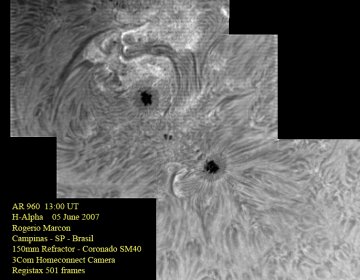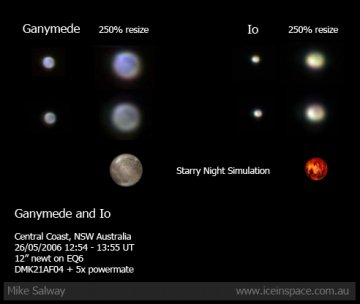 Would you like to hear about solar flares--while they're flaring? Get instant alerts from SpaceWeather PHONE. Would you like to hear about solar flares--while they're flaring? Get instant alerts from SpaceWeather PHONE. VENUS FLYBY: Today when NASA's MESSENGER spacecraft flies by Venus en route to Mercury, the craft will shoot a laser beam into Venus' clouds, among other experiments, to learn more about Earth's "evil twin." Get the full story from Science@NASA. FLARE! Solar activity continues: A few hours ago, amateur astronomers watching sunspot 960 caught a C6-flare in progress. "Changes were visible from moment-to-moment," report B. Morrissette and J. Stetson who took this picture from South Portland, Maine. CHANGING SUNSPOT: Behemoth sunspot 960 is morphing into a double spot. Each component in this morning's photo from Rogerio Marcon of Campinas, Brazil, is about the size of Earth: 
Sunspot 960: the view through a Coronado SolarMax60
The ongoing changes in sunspot 960 may signal the beginning of the spot's break-up. For now, it remains a threat for X-class solar flares; NOAA forecasters estimate a 20% chance of an X-flare during the next 24 hours. Stay tuned! more images: from Peter Paice of Belfast, Northern Ireland; from Alcaria Rego of Almada, Portugal; from Guilherme Grassmann of São Paulo, Brasil; from Sylvain Weiller of Saint Rémy lès Chevreuse, France; from Britta Suhre of Dortmund, Germany; from Maxim Usatov of Balovka, Dniepropetrovsk; from Pete Lawrence of Selsey, UK; from P-M Hedén of Vallentuna, Sweden; from John C McConnell of Maghaberry Northern Ireland; from Loyd Overcash of Houston, Texas; from Cai-Uso Wohler of Bispingen, Germany; MOONS OF JUPITER: Jupiter's moons are so big, their details are visible from backyards on Earth. Mike Salway of Central Coast, Australia, used a 12-inch Newtonian reflector to take these pictures of Ganymede and Io on May 26th: 
"To me, the surface markings are unmistakably real," says Salway. "In moments of great seeing, especially with Ganymede which is bigger than the planet Mercury, the features were seen in [individual video frames]." "I believe the egg shape of Io is due to darkened polar regions. The camera isn't sensitive enough to detect these dark regions against the black of space. When Io transits Jupiter, however, you can see the dark poles against the obviously bright planet." This is a great week to observe Jupiter's moons, and Jupiter itself, because the giant planet is at its closest to Earth for all of 2007. Stay tuned for more information. EXTRA: On May 11th, Salway recorded a fantastic movie of Jupiter and its largest moons. Expand your browser and click here. (770 kb) | 
